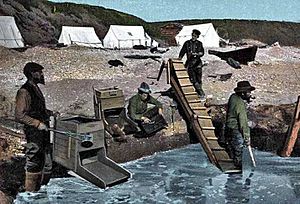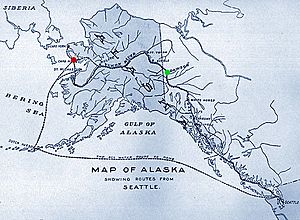Nome Gold Rush facts for kids
Quick facts for kids Nome Gold Rush |
|
|---|---|

Prospectors on Nome beach ca. 1900.
|
|
| Center | Nome, Alaska |
| Discovery | September, 1898, Anvil Creek |
| Duration | 1899–1909 |
| Goldfield | Snake River and beach at its outlet |
| Legacy | North to Alaska, 1960 |
The Nome Gold Rush was a time when many people rushed to Nome, Alaska to find gold. This happened mostly between 1899 and 1909. What made this gold rush special was how easy it was to find gold. A lot of gold was right there in the beach sand! People could collect it without even needing to claim the land. Nome was a busy sea port, even though it didn't have a proper harbor. It became the biggest town in Alaska for a while.
This gold rush was one of the biggest in North America, like the Klondike Gold Rush and the Fairbanks Gold Rush. Many people who looked for gold in Klondike later came to Nome. You can see the Nome Gold Rush in movies like North to Alaska. Nome City still exists today, and people still mine for gold there. Tourists can even try mining for fun. Over 112 metric tons of gold have been found in the Nome area.
Contents
History of the Nome Gold Rush
Before the Gold Rush: Nome's Early Days
The Nome Gold Rush happened around the town of Nome. This town is located where the Snake River meets the Seward Peninsula. This area is on Norton Sound in the Bering Sea. For hundreds of years before Europeans arrived, the Iñupiat people camped in the Nome area.
In the 1700s, Russians built a port called St. Michael. It was about 125 miles southeast of Nome. This port was used for sailing on the Yukon River. Fur traders and whalers from many countries visited the area. Some church missions were also set up in the 1880s. Before Nome, smaller amounts of gold were found in nearby places like Council, Alaska in 1897.
How Gold Was Discovered in Nome
In September 1898, three men found gold on Anvil Creek. They were called the "Three Lucky Swedes." These men were Jafet Lindeberg, Erik Lindblom, and John Brynteson. They started the Nome mining district. News of their discovery spread during the winter.
By 1899, Nome had 10,000 people. Many of them came from the Klondike gold rush. That same year, gold was found in the beach sands for miles along the coast of Nome. This made even more people rush to the area. Thousands more arrived in the spring of 1900 on steamships from Seattle and San Francisco. Some even came from Adelaide, Australia in 1902. By 1900, a huge tent city stretched 30 miles along the treeless coast.
Dealing with Claim Jumpers
Many people who arrived later were jealous of the first gold discoverers. They tried to "jump" the original claims. This meant they tried to say they owned the same land. A federal judge decided that the original claims were valid. However, some of the claim jumpers made deals with powerful politicians.
One politician, Alexander McKenzie, tried to take over mining claims. He did this with the help of a dishonest judge, Arthur H. Noyes. McKenzie's plan to take claims was eventually stopped by a higher court. This story became the plot for a famous novel called The Spoilers (1906). This book was made into plays and movies, including one in 1942 starring John Wayne. Because of these problems, Fort Davis was built in 1900 near Nome City.
How Gold Was Mined in Nome
Mining Gold on the Beach
Claim jumping was less of a problem once people found gold on the beach. This beach gold couldn't be claimed, and there was a lot of it. The beach gold was actually more important than the gold found in the creeks. Mining the Nome beach shows how gold rushes change. They start with simple tools and then use more machines and money.
At first, people used a pan to find gold on the beach. Later in 1899, they used human-powered tools like sluices and rockers. By 1900, small machines with hoses and pumps appeared on the beach. Finally, around 1902, large companies took over. The mining season was short because of ice. People could only work on the beaches from June to October. Local police made people without good shelter leave for the winter.
Mining Gold in the Creeks
Looking for gold in Alaskan creeks with a pan is slow and cold. Like in Klondike, there was a layer of frozen ground called permafrost just below the surface. In Nome, different machines were used to thaw the ground and suck up gravel. The goal was to process a lot of soil rather than being super efficient at separating gold.
People used water pressure to wash soil from creek banks into sluices. This was done either by gravity or by suction. Large machines called dredges were also used. Sometimes, mine shafts were dug. To make digging easier, the ground was softened with steam. Steam was also used to collect piles of gravel in the winter. This gravel was then washed for gold the next summer.
Life in Nome City
By 1905, Nome had many things a city needs. It had schools, churches, newspapers, a hospital, and stores. There was also a post office and an electric light plant. A greenhouse across the Snake River provided fresh vegetables. Some of the first automobiles in Alaska drove on the wooden planks of Front Street. People traveling to the mines in Council City rode in heated stagecoaches. In 1904, Nome had the first wireless telegraph in the United States that could send messages over 100 miles. Messages could go from Nome to St. Michael and then by underwater cable to Seattle.
Nome did not have a deep harbor for large ships during the gold rush. Ships had to anchor offshore. People and goods were brought to shore in smaller boats. In early summer, the coast could still be covered with ice. If this happened, passengers would get off on the ice and be taken ashore by dog sleds. In 1901, a loading crane was built. By 1905, a wharf was added. This was later combined with a tramway by 1907. The tramway was 1,400 feet long. It helped bring people and freight ashore using wire-pulled boats called lighters.
The End of the Gold Rush
In 1904 and 1905, more gold was found on old beaches above the high-tide line. This discovery brought new life to mining near Nome for a short time. However, these new finds didn't last long. Between 1900 and 1909, Nome's population reached as high as 20,000 people. But by the 1909 census, the population had dropped to 2,600. The main gold rush was over. However, gold mining still continues today, and prospectors still come to Nome every year looking for gold. The Nome district has produced at least 3.6 million ounces of gold, which is about 111.6 metric tons.
Who Made Money?
Among the Nome gold seekers, the "Three Lucky Swedes" definitely made a fortune. Around 1920, their mining company had earned $20,000,000. It's estimated that the average beach miner in 1899 earned about 2.5 years' worth of a worker's salary.
Business owners also made money during the rush. For example, Wyatt Earp, a famous lawman, is thought to have returned from Nome with $80,000. Another well-known gold seeker, Swiftwater Bill, made a fortune in both Klondike and Nome, but he lost it all just as quickly.
Impact on Native People and Nature
The gold rush had a big impact on the native people. Only citizens could legally claim land for mining. Native people were not considered citizens at that time, so they couldn't claim land. For them, the gold rush meant fewer moose, caribou, and small game animals. Gold seekers hunted these animals for food. In many areas, gold mining also damaged salmon streams. Contact with the new settlers also brought challenges like new illnesses.
Legacy of the Nome Gold Rush
The places where the "Three Lucky Swedes" first found gold are now important historical sites. They were added to the National Register of Historic Places in 1976. In 1978, these three spots, plus a fourth important beach area, were named a National Historic Landmark District. This fourth site is a 0.6-mile stretch of beach on the eastern edge of Nome.
Nome and Klondike Gold Rushes: What's the Difference?
The Nome Gold Rush is sometimes overshadowed by the more famous Klondike Gold Rush. It's important not to confuse them. Both are often thought of as Alaskan gold rushes, but only Nome is actually in Alaska. The Klondike Gold Rush happened near Dawson City in the Yukon Territory, Canada.
However, the two places are connected by the Yukon River. This river starts in Canada and flows through the Yukon Territory and then into Alaska. It ends in Norton Sound, which is across from Nome. So, the Yukon River is linked to both rushes. As mentioned, some gold seekers went to both Klondike and Nome. Also, they sometimes used the same travel routes.
Nome Gold Rush in Movies
The novel The Spoilers was made into several movies. These include versions from 1955, 1942 (starring John Wayne), 1930 (with Gary Cooper), and 1914. The movie North to Alaska (1960), a comedy also starring John Wayne, is set in Nome during the rush. It's also known for its theme song. In the movie Wyatt Earp (1993), which is about the life of Wyatt Earp, there's a short scene at the end that mentions Nome.






